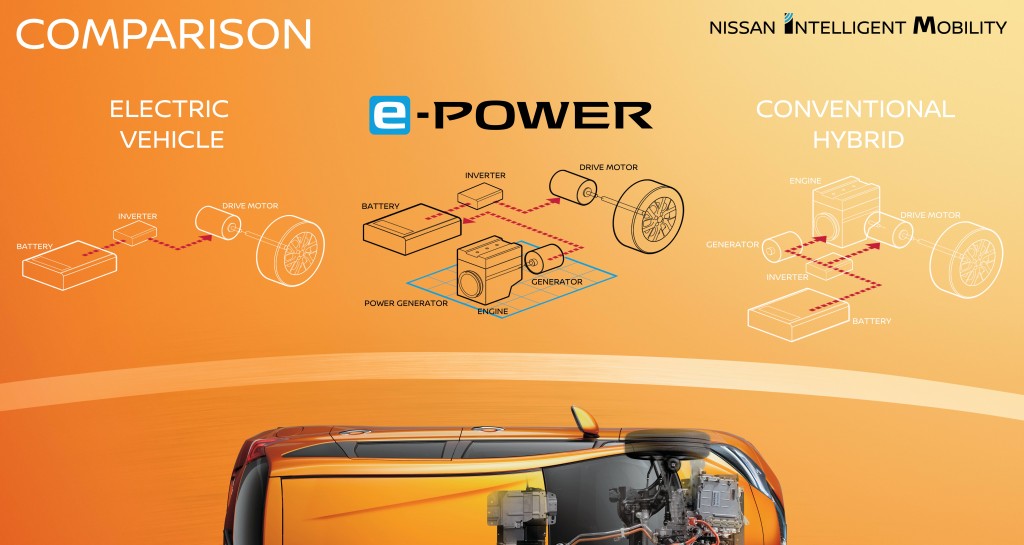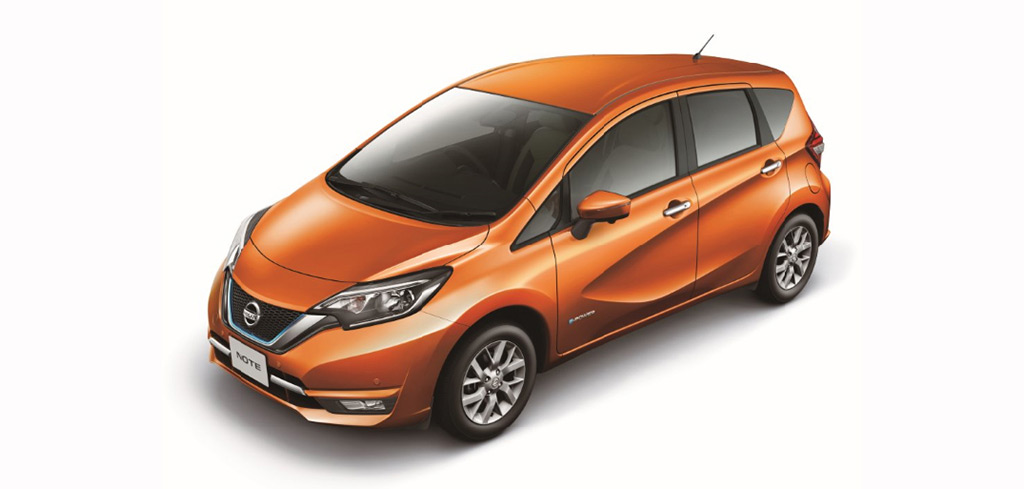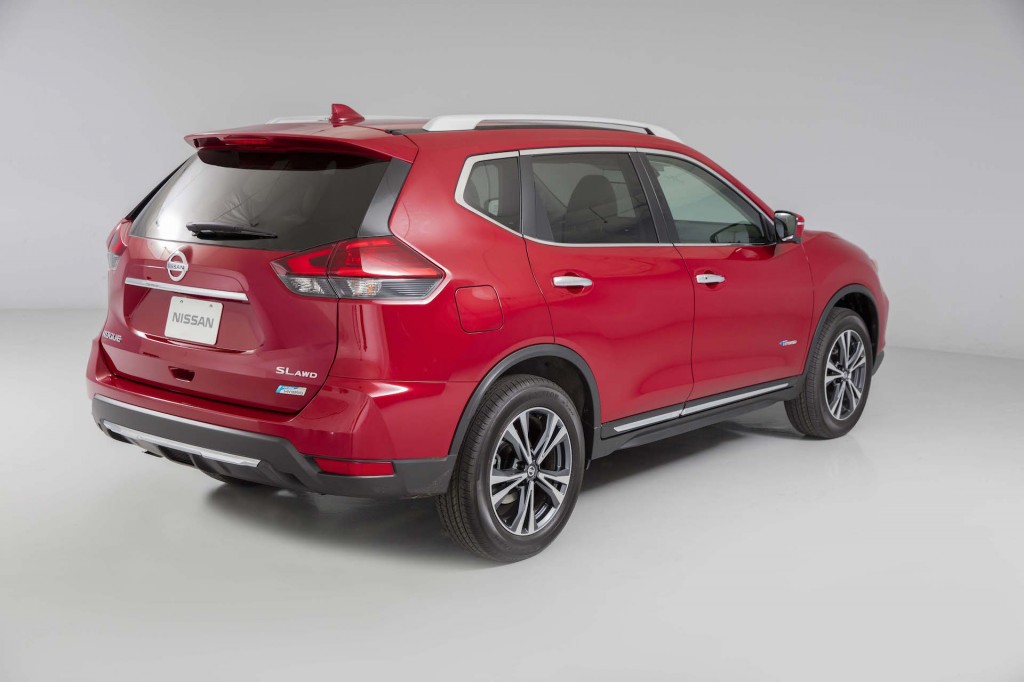This morning, in Japan, Nissan unveiled what its lineup has long been missing: strong hybrid technology.
The company's new e-Power hybrid system, demonstrated in a Nissan Note hatchback, contains a gasoline engine and an electric traction motor.
But unlike the power-split hybrids used by Toyota and others, Nissan's system propels the wheels solely with the electric motor—and the small engine only charges the battery.
DON'T MISS: Nissan Note hybrid leaked, but not likely for North America
Known as a series hybrid (rather than the parallel hybrids used by most other makers), the Nissan system builds on the company's long expertise in electric cars.
The e-Power system is not a plug-in hybrid—at least not yet—but a different approach to combining the benefits of electric drive and gasoline-engine output.
The benefit is a fully electric driving experience, with maximum torque available from a stop and smooth, stepless power delivery up to the car's top speed.

Nissan Note e-Power hybrid
"The e-Power system allows you to enjoy all the benefits of an EV without having to worry about charging the battery," the company says.
The Japanese marketing campaign for the car, in fact, stresses the driving experience in its slogan: "You'll love it with your foot on the pedal."
READ THIS: Nissan To Launch Plug-In Hybrids Too, In Less Than Two Years (Jun 2014)
In a video ad (which you can watch at the bottom of page 2), 91 percent of drivers who tested the Note e-Power said they noted a difference in acceleration, 96 percent said they "loved it when they pushed the pedal," and 84 percent said they "felt the future."
The new hybrid system is, Nissan says, "a gateway to 100-percent electric cars," designed to further the company's goals for zero-emission vehicles.

Nissan Note e-Power hybrid
And its engineers drew heavily on the company's experiences with the Nissan Leaf, the world's best-selling electric car, with global sales that have now crossed 250,000 units.
The Note e-Power uses a small lithium-ion battery pack, and an unspecified engine, tuned to run most efficiently at 2500 rpm, to power the generator that charges the battery.
As in any hybrid or electric car, regenerative braking captures otherwise wasted energy to recharge the battery as well.
Nissan says the fuel economy ratings of the Note e-Power are expected to be similar to those of "leading conventional hybrids." That's likely a reference to the Toyota Prius, rated at 52 to 56 mpg combined in the U.S.

Nissan Note e-Power hybrid
But the company was stingy with technical details in its press materials, which did not specify the battery capacity, engine output, or motor power.
References to the use of a Leaf motor, however, would indicate an output of approximately 80 kilowatts (110 horsepower).
WATCH THIS: 2017 Chevrolet Bolt EV: video review of 238-mile electric car
The closest hint on battery size was a comment from chief powertrain engineer Naoki Nakada, who said it had been challenging to split apart the components of the powertrain and to minimize battery size.
"Compared to the Leaf," he said, "the batteries are one-twentieth the size—and made to fit under the front seats without having to sacrifice interior space."

2016 Nissan Note e-Power
That one-twentieth statistic likely refers to the physical dimensions and volume of the pack itself.
But if applied to the 30-kilowatt-hour capacity of the current Leaf battery, it would work out to 1.5 kwh—very close to the average hybrid battery used by Toyota, Ford, and others.
The Nissan Note e-Power gives the company an important entry into the domestic market in Japan, where more than half the new cars sold are now hybrids, aided by generous financial incentives.
In that market, the Note e-Power will start at a price below 2,000,000 yen ($29,600) and come in 13 colors.

Nissan Note e-Power hybrid
The e-Power system will likely spread to other models in the Nissan lineup as well, both domestically and in other markets.
The company has already acknowledged that its upcoming Gripz sporty hatchback will offer the system as well.
Whether it will come to North America, however, remains unclear.
CHECK OUT: 2017 Nissan Rogue Hybrid: better prospects for small hybrid SUV than Pathfinder, Murano?
The Nissan Note, popular elsewhere in the world, is sold as the Versa Note in North America.
Its starting price is little more than half that of the Note e-Power in Japan, indicating that if the e-Power system is to come to North America, it would likely have to be in a higher-priced vehicle.
The 2017 Nissan Rogue Hybrid compact crossover has just been introduced in the U.S., at least nominally competing with the Toyota RAV4 Hybrid.

2017 Nissan Rogue Hybrid
The hybrid Rogue, however, uses a higher-power version of the company's older mild-hybrid system—and that powertrain has not been a sales success in the larger Pathfinder and Murano crossovers.
If we ever get a chance, we'll bring you a drive report on the Note e-Hybrid—perhaps the closest sibling in the Nissan lineup to the Leaf electric car, if you ignore the e-NV200 electric delivery van.
Meanwhile, here's that video ad in which drivers discuss their impressions (in Japanese) after getting behind the wheel of a Nissan Note e-Hybrid.
[Green Car Reports thanks our reader Brian Henderson, who stayed up to watch the live webcast and sent us notes on the launch event and the Note e-Power marketing campaign. This article incorporates some of that material.]
_______________________________________













